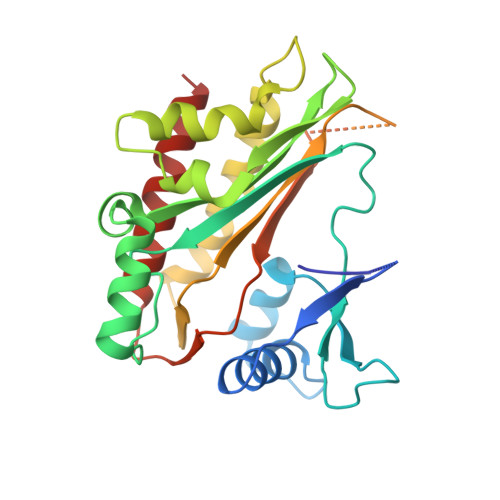Crystallographic and kinetic analyses of human IPMK reveal disordered domains modulate ATP binding and kinase activity.
Seacrist, C.D., Blind, R.D.(2018) Sci Rep 8: 16672-16672
- PubMed: 30420721
- DOI: https://doi.org/10.1038/s41598-018-34941-3
- Primary Citation of Related Structures:
6E7F - PubMed Abstract:
Inositol polyphosphate multikinase (IPMK) is a member of the IPK-superfamily of kinases, catalyzing phosphorylation of several soluble inositols and the signaling phospholipid PI(4,5)P 2 (PIP 2 ). IPMK also has critical non-catalytic roles in p53, mTOR/Raptor, TRAF6 and AMPK signaling mediated partly by two disordered domains. Although IPMK non-catalytic functions are well established, it is less clear if the disordered domains are important for IPMK kinase activity or ATP binding. Here, kinetic and structural analyses of an engineered human IPMK lacking all disordered domains (ΔIPMK) are presented. Although the K M for PIP 2 is identical between ΔIPMK and wild type, ΔIPMK has a 1.8-fold increase in k cat for PIP 2 , indicating the native IPMK disordered domains decrease IPMK activity in vitro. The 2.5 Å crystal structure of ΔIPMK is reported, confirming the conserved ATP-grasp fold. A comparison with other IPK-superfamily structures revealed a putative "ATP-clamp" in the disordered N-terminus, we predicted would stabilize ATP binding. Consistent with this observation, removal of the ATP clamp sequence increases the K M for ATP 4.9-fold, indicating the N-terminus enhances ATP binding to IPMK. Together, these structural and kinetic studies suggest in addition to mediating protein-protein interactions, the disordered domains of IPMK impart modulatory capacity to IPMK kinase activity through multiple kinetic mechanisms.
Organizational Affiliation:
Department of Pharmacology, Vanderbilt University School of Medicine, Nashville, TN, 37232, USA.















